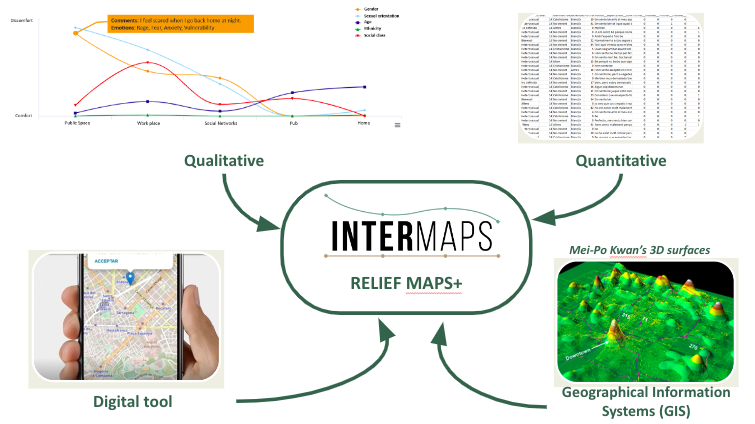The project
About Intermaps
INTERMAPS is a project led by Maria Rodó-Zárate, based at the Pompeu Fabra University (Barcelona) and funded by the European Research Council (ERC Starting Grant, 2021).
It aims to contribute to the study of inequalities and discriminations by proposing a specific framework that can establish a systematization and characterization of intersectional dynamics.
It includes a new theoretical model for conceptualizing intersectional inequalities from a spatial and emotional perspective and the development of new specific methods that combine and integrate qualitative, quantitative, digital and spatial (GIS) approaches.

INTERMAPS wants to contribute to the understanding of how structural inequalities are (re)produced and how they differently affect people’s everyday lives, building bridges between feminist and postcolonial theories, critical geographies and political and social sciences.
Objectives
INTERMAPS aims to make a twist on the course of research in intersectionality studies by proposing a new theoretical and methodological model that, while maintaining the origianl purposes of the concept, develops a specific framework that can establish a systematization and characterization of intersectional inequalities and provoke a significant shift in how intersectional dynamics are understood.
The main objectives are:
1. Theoretical
INTERMAPS aims to develop a new theoretical model for conceptualizing intersectional dynamics based on three innovative approaches:
a) the consideration of the relation between categories through a properties framework and a pluralist and contextual approach,
b) a conceptualization of space as constitutive of intersectional dynamics, and
c) an incorporation of the emotional dimension of intersecting inequalities.
2. Methodological
INTERMAPS will develop a new methodological model for research on intersecting inequalities, based on the theoretical model described above. Its main innovation will be the combination and integration of qualitative, quantitative and spatial approaches. This will include the creation of new digital tools for collecting data based on Relief Maps, the development of new analytic methods, and the creation of new forms of data visualization.
The development of these new methods will be based on Relief Maps: a qualitative tool created by Maria Rodó-Zárate (PI), which has provided preliminary results that justify the feasibility of this approach. The aim is to turn this tool into a theoretical and methodological model by developing it as both a quantitative and a qualitative tool and creating a new version with Geographic Information Systems that allows the collection, analysis and visualization of intersectional inequalities in maps. The new methodological model will integrate both quantitative and qualitative data, digital tools, geolocalization and participatory approaches in order to map intersectional dynamics.
These methods will allow us to identify patterns of who (which social positions) experiences inequality and discrimination (by which causes), where (in what specific contexts), and how these experiences are configured (which specific characterization, qualitative data). The main hypothesis of this project is that inequality and discrimination vary depending on social positions and places, and that they follow patterns that can be empirically identified.
3. Empirical
The theoretical and methodological model to be developed will be applied to a specific case study in Catalonia (Spain), following an intercategorical approach (McCall, 2005) that will consider all dimensions in diverse axes. This will allow an analysis of intersectional dynamics in themselves, as well as the creation of new indicators of intersectional inequality and discrimination, and the establishment of a spatially situated characterization of intersectional dynamics.
For this reason the project envisions to cover a sample of 1.000 people. In this sense, there is no specific group to be studied, but rather the entire population (above 8 years of age).
The empirical pillar of the project will have the potential to show the existence of patterns that may challenge prevailing understandings of intersectionality as an overly complex and messy phenomenon that cannot be empirically characterized in itself.
